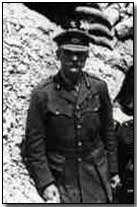Battles - The First Battle of Krithia, 1915
 Having established
beachheads at Cape Helles and Anzac Cove on the southern tip of the
Gallipoli peninsular in the wake of the
landings of 25
April 1915, Commander-in-Chief
Sir Ian Hamilton
determined to open the
peninsular land
campaign by breaking through the Turkish defensive lines via the main
Allied force at Cape Helles, capture Krithia and so link up with the
remaining force at Anzac Cove.
Having established
beachheads at Cape Helles and Anzac Cove on the southern tip of the
Gallipoli peninsular in the wake of the
landings of 25
April 1915, Commander-in-Chief
Sir Ian Hamilton
determined to open the
peninsular land
campaign by breaking through the Turkish defensive lines via the main
Allied force at Cape Helles, capture Krithia and so link up with the
remaining force at Anzac Cove.
Local Allied commander Aylmer Hunter-Weston - who had singularly failed to distinguish himself during the original landings by failing to press forward while he had the opportunity - had however already suffered notable casualties during the landings. His force had dwindled from 20,000 to just 14,000 men, including 5,000 French colonial troops.
Furthermore Hunter-Weston's supply position was critical. A mere 28 guns had been landed, many machine guns had been lost and there were sufficiently few pack animals that infantrymen were required to carry all of their own equipment, food and ammunition.
Facing him in the 7km line stretching across the southern tip of the peninsular was a roughly equivalent Turkish force under the command of regional commander Liman von Sanders.
Hamilton ordered Hunter-Weston to seize control of Krithia to the immediate rear of the Turkish line, and with it Achi Baba, a prominent (and heavily defended) 200-metre hill feature some 2km beyond Krithia. Hamilton had originally intended that Achi Baba should be seized on the first day of the landings; convinced of its great strategic value he was henceforth persistent in striving for its capture (some present-day Australian historians argue that the feature was by no means as important as Hamilton believed).
 Once
Krithia was in Allied hands Hamilton intended to continue to push
northwards, removing Turk defenders from the heights defending the
Dardanelles Straits. The ultimate aim of the campaign was the capture
of the Turkish capital Constantinople and control of the Straits. The
latter would provide the Allies with a key supply route to their Russian
partners.
Once
Krithia was in Allied hands Hamilton intended to continue to push
northwards, removing Turk defenders from the heights defending the
Dardanelles Straits. The ultimate aim of the campaign was the capture
of the Turkish capital Constantinople and control of the Straits. The
latter would provide the Allies with a key supply route to their Russian
partners.
Thus Hunter-Weston initiated what became the first of three battles of Krithia at 8am on 28 April 1915 with a moderate bombardment. The British attacked the extreme left of the Turkish line while French forces under General d'Amade attacked the extreme right. The intention was to progress up the spine of the peninsula and capture Krithia from the rear.
Both attacks were however readily repulsed in spite of encouraging initial progress. Indeed the British line to the left actually broke in the face of a Turkish bayonet charge and had to be rescued with a prolonged off-shore bombardment from HMS Queen Elisabeth.
Attacks at the centre of the line, opposed by a mere 200 Turkish troops, were nevertheless also thrown back with great loss. Realising the futility of his position Hunter-Weston consequently abandoned the attack at 6pm. His troops returned to the trenches they had left in the morning.
Allied casualties during the battle were heavy, with approximately 3,000 losses from the original force of 14,000. Three days later Turkish minister of war Enver Pasha instructed Liman - an attached German officer - to strike back at the Allied force.
A further Allied attack was launched following a pause for reinforcement on 6 May: the Second Battle of Krithia.
To view maps detailing the progress of the Gallipoli campaign click here; and here; and here; and here.
Photographs courtesy of Photos of the Great War website
A "Communication Trench" was a narrow trench constructed at an angle to a defensive trench to permit concealed access to the defensive trench.
- Did you know?
